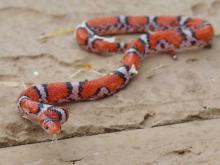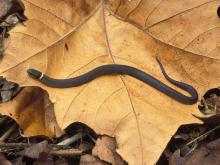Reptiles and Amphibians
Media

Species Types
Scientific Name
Thamnophis proximus proximus
Description
The orange-striped ribbonsnake is a type of gartersnake named for the attractive orange or yellow stripes running the length of its body, alternating with wide black stripes. It is found statewide, but seldom far from water.
Media

Species Types
Scientific Name
Cemophora coccinea copei
Description
One of Missouri's most brilliantly colored snakes is also extremely rare to find. The northern scarletsnake is similar in pattern and color to the more common red milksnake but has a red or orange snout and a spotless, white belly.
Media

Species Types
Scientific Name
Lampropeltis triangulum
Description
The harmless eastern milksnake is white, yellow, or light tan, with red or orange blotches bordered with black. The belly is white and strongly checked with black. This species often is misidentified as the venomous coralsnake, which is not found in Missouri.
Media

Species Types
Scientific Name
Terrapene carolina triunguis
Description
The three-toed box turtle usually has three hind toes. Its high-domed shell usually has a top ridge and is olive or brown with faint yellow or orange lines. Look for it in woodland habitats.
Media

Species Types
Scientific Name
Acris blanchardi (formerly Acris crepitans blanchardi)
Description
Blanchard's cricket frog is a nonclimbing member of the treefrog family. It lacks the adhesive toe pads associated with treefrogs. It occurs statewide. The call is a metallic “gick, gick, gick.”
Media

Species Types
Scientific Name
Thamnophis sirtalis sirtalis (eastern gartersnake) and T. s. parietalis (red-sided gartersnake)
Description
The eastern gartersnake and red-sided gartersnake are Missouri's most common gartersnakes. The color is variable, but there are normally three yellowish stripes, one down the back and one on each side. There are narrow black bars between the scales along the upper lip.
Media

Species Types
Scientific Name
Storeria occipitomaculata
Description
The red-bellied snake is one of Missouri's smallest snakes. It is gray or reddish brown on top, usually with narrow stripes, and bright red or orange below. It occurs nearly statewide but appears to be absent from the northwest and southwest corners.
Media

Species Types
Scientific Name
Diadophis punctatus arnyi
Description
Prairie ring-necked snakes are easily recognizable by their small size, uniform dark color on the back, bright yellow-orange belly, and distinct yellow ring around the neck. Secretive, but common nearly statewide.
Media

Species Types
Scientific Name
Plestiodon fasciatus
Description
The common five-lined skink is one of Missouri's most abundant skinks. Adults are olive or tan with lengthwise stripes. It is often called the blue-tailed skink for the coloration of juveniles. Occurs nearly statewide.
Media

Species Types
Scientific Name
Plestiodon laticeps
Description
The broad-headed skink is a large, smooth-scaled lizard that lives in the southern two-thirds of Missouri. It is frequently confused with the common five-lined skink, which is smaller.
See Also
About Reptiles and Amphibians in Missouri
Missouri’s herptiles comprise 43 amphibians and 75 reptiles. Amphibians, including salamanders, toads, and frogs, are vertebrate animals that spend at least part of their life cycle in water. They usually have moist skin, lack scales or claws, and are ectothermal (cold-blooded), so they do not produce their own body heat the way birds and mammals do. Reptiles, including turtles, lizards, and snakes, are also vertebrates, and most are ectothermal, but unlike amphibians, reptiles have dry skin with scales, the ones with legs have claws, and they do not have to live part of their lives in water.





















